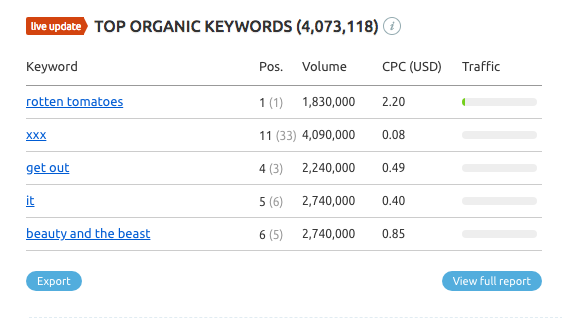Everyone will agree to the fact that getting anything to rank, whether it be an ecommerce store or a personal blog, is certainly a hectic task.
However, we can utilize one of the fundamental elements in digital marketing: content.
Content is king, it works wonders in helping you rank, drives visitors for conversion and gets you just the right amount of exposure to promote your brand in ways that you can’t even imagine.
In this short article, I’ll discuss ways to help you automate your blogging plan, promote your content, and get potential customers in your store to drive efficient conversions.
What Should You Write About?
The basis of all content that is centered on driving conversions is keyword research. Now there are a lot of ways to conduct keyword research and there are a myriad of tools that can help you. AHREFS, SEMRush and Moz have excellent tools that can help you identify low-lying fruit or keywords that you can rank for easily.
However, there’s a technique called Keyword Opposition to Benefit Analysis (or KOB Analysis) that you can easily utilize if you’re looking to rank your content. It works by checking out what keywords your competitors are ranking for and hijacking them.
In order for you to do this, you’ll need SEMRush, which is a great tool for competitor analysis. For this example, I”ll be using a completely random site, imdb.com.
Type in your domain name and hit search.
On the left hand site click “Organic Research”, followed by “Competitors”.
Check out their biggest competitor, in this case Rotten Tomatoes.
Click on the major competitor. Scroll down until you find their organic keywords. Click “View full report”.
Hit the filters and leave out the ones that are over position 20 and export the data. The full report should look like this.
Once the data has been exported to excel. It’s time to filter it out.
You filter these keywords using the KOB equation:
Opposition / Benefit = KOB Score
The higher, the better.
The quick way to calculate opposition is to get its keyword difficulty from SEMRush and divide it by its benefit. Benefit is equal to its CPC rate multiplied by its average search volume.
So create a new column entitled keyword difficulty and stick in a formula that looks like this:
=cell with KD or keyword difficulty/(cell with CPC*cell with search volume)
Drag it down to populate the rest of the cells.
Now:
- Add a column where you can put in the topic of that particular keyword (and what sort of content was in the URL).
- Now organize the competitor URLs and label it depending on which topic it belongs to.
- Now create a sheet that looks like this:
- Now list these topics one by one in terms of good KOB score in this new sheet that you have created. Only pick the ones with a high KOB.
Which ones do you pick?
Do a Google search for each of the keywords; pick the ones that have a combination of these factors:
- Good CPC rate
- Adequate monthly search volume
- No ads on the search (ads indicate competition and a hard keyword to rank for)
- Are low authority websites ranking for that keyword (this is a good sign)
- Journey or how will it be funneled to a sale
You have an area called “New or Rewrite” where you get to decide if you should rewrite existing content or produce new ones.
You can now start adding these keywords to your content calendar and designing content around them.
Content Calendars and Getting Your Team Together
Once you’ve planned out the keywords that you want to target for the entirety of the month or quarter, it’s time to map out when you will be releasing content. Getting a content team together is no longer a tricky process.
There are two ways to go about this and you can always do a mix of both. You can have in-house writers or you can outsource the entire team.
Sites like Upwork or Fiverr are popular with freelancers and people looking to outsource.
The essential people that you’ll need are: your writers and an editor. Optionally, you can go get yourself a content manager who can handle the entire operation for you and a couple of people whose job is to promote the posts.
Automating Content and Drafting
The first step in content automation is getting your systems in place. There are various ways for you to do this. The easiest and probably the most utilized way to automate content is by using a Google sheet.
Using Google Sheets, you can get your content writing team to collaborate on one spreadsheet so you can track the progress of your entire blogging plan. A simple content process sheet can look like this:
As you can see, everything is laid out simply and clearly.
- Date assigned
- Due date – Allow your writer a few days to complete the task. Remember this due date is primarily for the editor.
- Title – Sums up the overall theme of the blog post
- Primary Keyword
- Secondary or Supporting Keywords
- Notes – How you want your article written
- Progress – Is it in progress, completed, or drafted?
- Drafted URL – The URL of their drafted post.
- Editor’s Notes – Has the editor approved of the post or are changes required.
- Published URL – The live link to the article once the editor, content manager or yourself has finally approved it for publishing.
Basically, you or your content manager assigns an article to one of the writers according to the content calendar’s schedule, the details are filled up and the deadlines are given.
To make things easier, you can give the writer limited access to the backend of your site so that they may draft their content there. Once they save it, they can just copy the draft URL and paste it on the sheet.
They mark their progress and the editor is alerted to proofread the piece. Once that process is done you can then publish the article or assign someone to publish it for you.
Why It Works and Other Alternatives
It’s a barebones approach that relies on everyone in the chain ensuring that they update the sheet accordingly. If you want to choose to go about the spreadsheet route but want something more powerful, Smartsheet offers a slightly more powerful alternative to Google Sheets.
If you want something more visual, online project management systems like Trello or MeisterTask can really help.
Trello uses cards with each task and its corresponding details. You can fill each card with notes, checklists, attachments, and even assign certain people to follow these cards.
Just get your team to drag the cards to their correct positions based on progress.
Content Promotion Strategies
There are basic content promotion strategies – like social media promotion, but there are better ones.
Finding an influencer to pseudo-sponsor your content is a great strategy in content promotion. Apps like BuzzSumo can help facilitate your search for influencers.
An influencer can promote your content, let you write for them (sometimes), direct some of their followers to your content, and be a major asset in driving conversions.
Now don’t let your assistants do the work when you’re reaching out to influencers, send them a nice, short concise email telling them about your plan.
Don’t be sycophantic. Personalization is key.
Also, consider a syndicated press release from a press release provider. These services send out your content or whatever you want released to a variety of sites in minutes. Services like iReach can help you out with this.
Alternative Promotion
An effective tool that digital marketers still use is outreach link building. Instead of writing content for your own blog, you can offer to write content for another site that links to your site. You’ll benefit from their authority and reach, and you’ll even get a link directed at your site.
Let me summarize the steps involved in the outreach process. It starts with collecting prospects followed by identifying the most apt content topic for a particular prospect.
The next part involves personalizing the emails and using an email marketing software like Mailchimp or Constant Contact to automate the entire process including scheduling and email tracking. Once, the campaigns are set and scheduled, it’s time to play the waiting game.
So there you have it, a quick way to get your keywords, content calendars and article automation for better conversions using content.

















